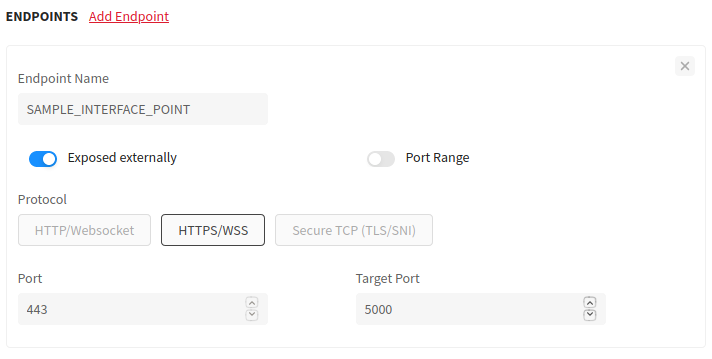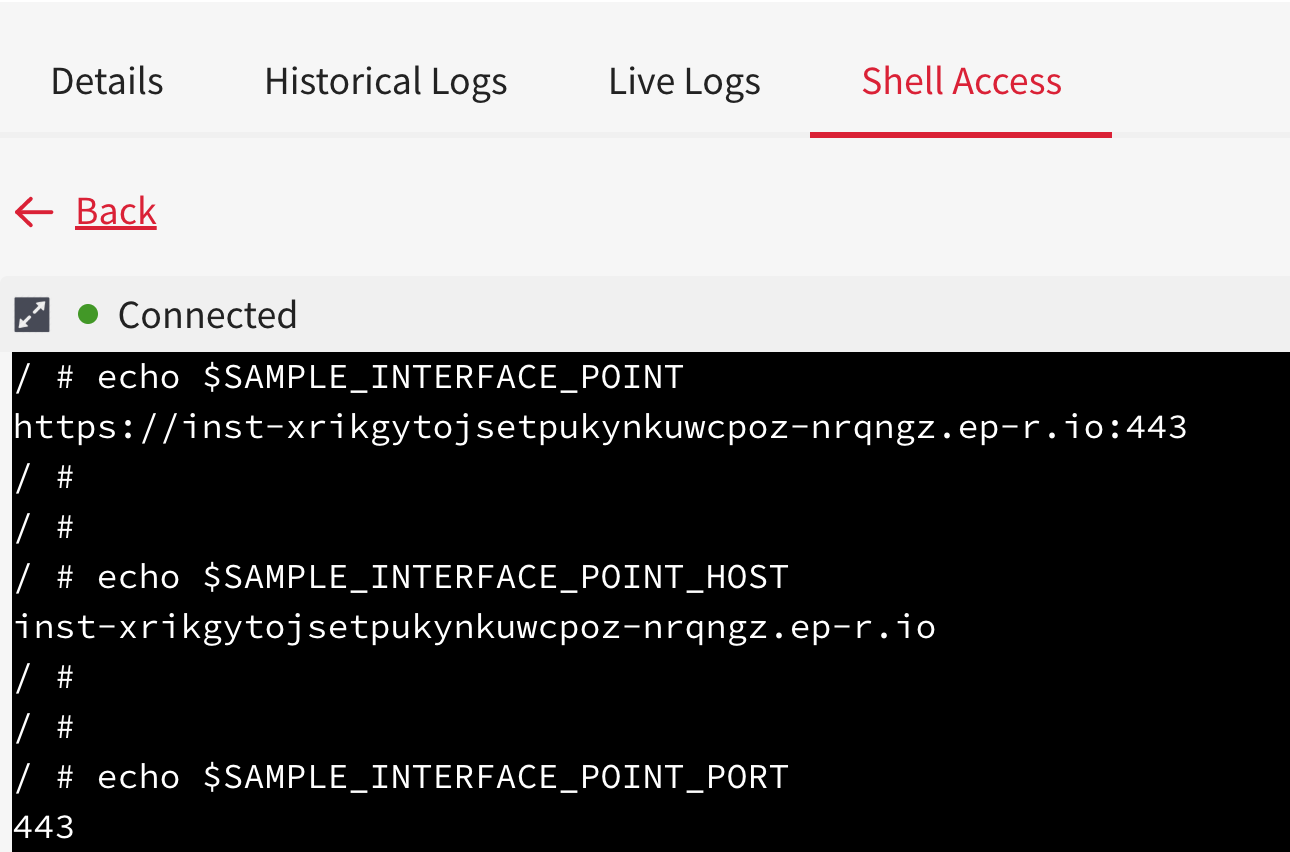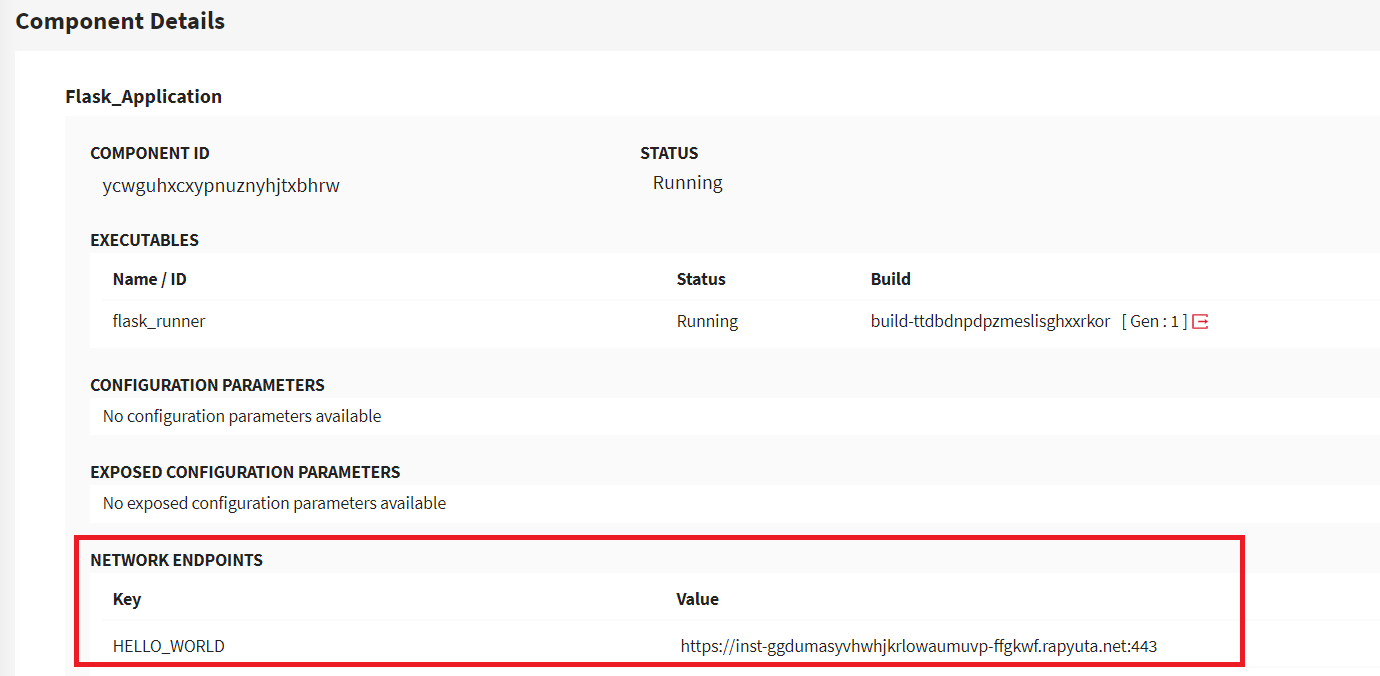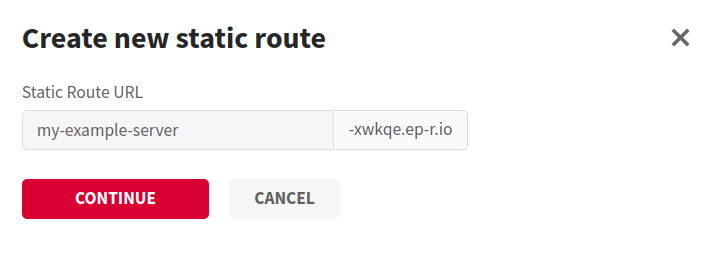In this article
Help us make these docs great!
All rapyuta.io docs are open source. See something that's wrong or unclear? Submit a pull request.
Make a contributionPackage Internal
What is a package?
A package is a fundamental rapyuta.io resource that represents a declaration of your application. A package is the smallest unit of deployment in rapyuta.io. It can be deployed either on a device or the cloud or both.
A package encapsulates information about what strategy is used to build it, its compatibility and runtime requirements, network endpoints and ROS interfaces it exposes, and any configuration information it may require.
Each package consists of components, which are made up of individual executables.
Executables
Executables within a component are always executed on the same physical/virtual compute node and share a ROS Master (in the case of ROS applications). An executable is a runnable entity such as:
- rapyuta.io Builds
Executables can reference existing rapyuta.io Build. Builds help you create a GitOps pipeline by specifying a repository and a build recipe. rapyuta.io can then build your git source code into a container image. Executables referencing builds use the generated images at the time of package deployment. Custom bash command can additionally be specified and is executed when the package is deployed.
Executables referencing builds use docker images at the time of deployment, Packages containing such executables can’t be deployed on devices with a Preinstalled runtime
- Docker image
A docker image is used as an executable. When a deployment is triggered, rapyuta.io pulls a docker image from the docker registry. Additionally, you may specify a bash shell command for the docker container.
The maximum size of the docker image is 10GB for cloud deployment. If your docker image is private, then you will need to create a docker secret and provide it in credentials.
- Bash command
A simple bash shell command is an executable. If you choose the Executable Type as Default, the bash shell command becomes executable. In this case, the executable can run only on Preinstalled device runtime. rapyuta.io assumes that all dependencies that are required to run the command are already present on the device where the command will execute.
Components
A component is a set of executables. All executables are deployed in unison on the desired Component Runtime. All executables of a component communicate via Inter-Process Communication (IPC. An executable listening on a port is accessible to its sibling executables via localhost.
The number of volumes attached to a component must be less than or equal to the sum of all the CPU cores of all executables of a component. Mathematically,
number of volumes attached to a component <= floor(sum of all the CPU cores of all executables in the component)
Suppose a component has two executables, execA and execB. The executables may have the following cpu core values:
- execA: 1 cpu core, execB: 0.5 cpu core, number of volumes attached is 1
- execA: 1 cpu core, execB: 2 cpu cores, number of volumes attached <= 3
- execA: 0.5 cpu core, execB: 0.5 cpu core, number of volumes attached is 1
Components are further nested into plans. A rapyuta.io “package” may contain multiple plans, and each plan represents a different configuration of a package. At this point, when you add a new package to the rapyuta.io, there is always a single plan associated with the package. A plan is uniquely identified by its plan ID
Component Runtime
A component of a package may be deployed either on the cloud or on a device.
When deployed on the cloud, the component has cloud runtime. Whereas, the component deployed on a device has device runtime.
Configuration Parameters
configuration parameters operate at the level of component and apply to executables in the component only
In line with the 12-Factor application philosophy, rapyuta.io allows the package author to pass configuration as environment variables that may be consumed by executables running within a component. These are mapped to environment variables made available to your code. They are modeled as key-value pairs (where both the key and the value are strings) accessible by the user’s code using standard environment variable look-up techniques provided by the programming language. The package author can choose to provide default values. These values may be overridden by the user while deploying the package.
A package may choose to declare environment variables as exposed from within its constituent components allowing dependent deployments to receive these values during the deployment binding phase.
The platform injects environment variables corresponding to exposed parameters.
Network Endpoints
Individual components of a package expose network endpoints, which are defined by users.
When creating an endpoint, you must provide a name for the endpoint, select the desired network protocol, and specify a target port.
The name of a network endpoint must consist of alphabets, digits, or an underscore ( _ ) and must not begin with a digit.
Port is where the application’s service is made visible to other services.
Target port is where the application needs to be listening for network requests for the service to work.
rapyuta.io injects network endpoints as environment variables during the deployment phase.
Suppose that a package defines a network endpoint, SAMPLE_INTERFACE_POINT, which is externally exposed. The port and target port are set to 443 and 5000, respectively. When the package is deployed, rapyuta.io injects SAMPLE_INTERFACE_POINT as an environment variable. You can access all of the environment variables in a deployment via the Shell Access option.
Click on Shell Access > SSH to open a Linux terminal of the deployment. Enter the following commands the network endpoint, its host URL address, and port.
echo $SAMPLE_INTERFACE_POINT
echo $SAMPLE_INTERFACE_POINT_HOST
echo $SAMPLE_INTERFACE_POINT_PORT
Exposing Endpoints Internally
You can restrict access to a network endpoint by ensuring that Exposed externally option is not selected.
The only protocol available is the TCP for which the value of the Port field is set to 443 by default. However, you can change the port’s value.
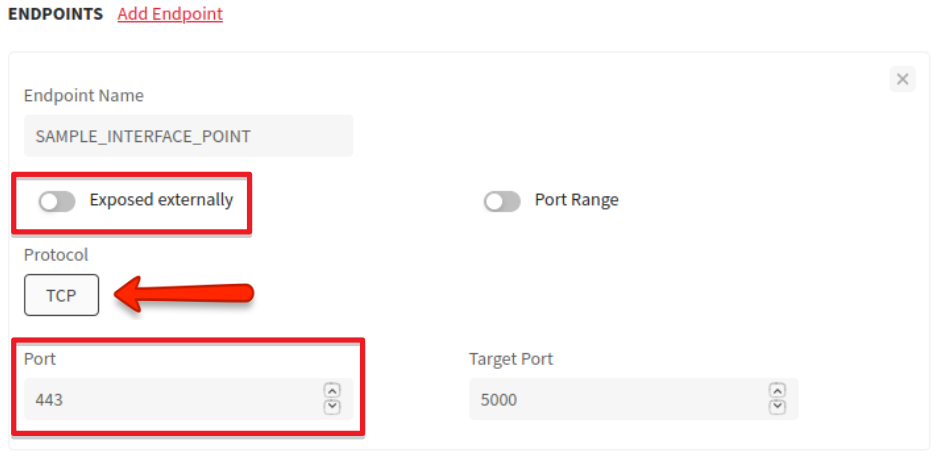
You can also use port range for an endpoint by selecting Port Range toggle. A Port Range on an endpoint will allow you to open multiple ports on a single DNS hostname.
-
By default the Target Port is the same as the Port.
-
A maximum of 50 ports are allowed for an endpoint. The allowed format is a comma-separated Port Ranges. Each Port Range is either a single port or a range of port mentioning the from port and to port separated by a hyphen (-). Examples: 5000 or 443-445 or 3446-3449,3500,3510-3530
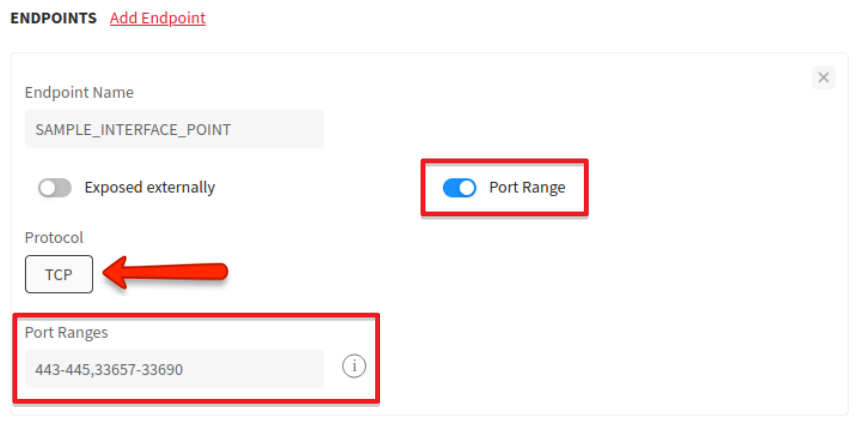
Exposing Endpoints Externally
Select Exposed externally checkbox to expose a network endpoint publicly over the internet.
The supported protocols at their respective ports (cannot be modified) are:
- HTTP/Websocket exposed on port 80
- HTTPS/WSS exposed on port 443
- Secure TCP (TLS/SNI) exposed on port 443
The Secure TCP (TLS/SNI) protocol uses SNI headers for routing the request to the desired backend.
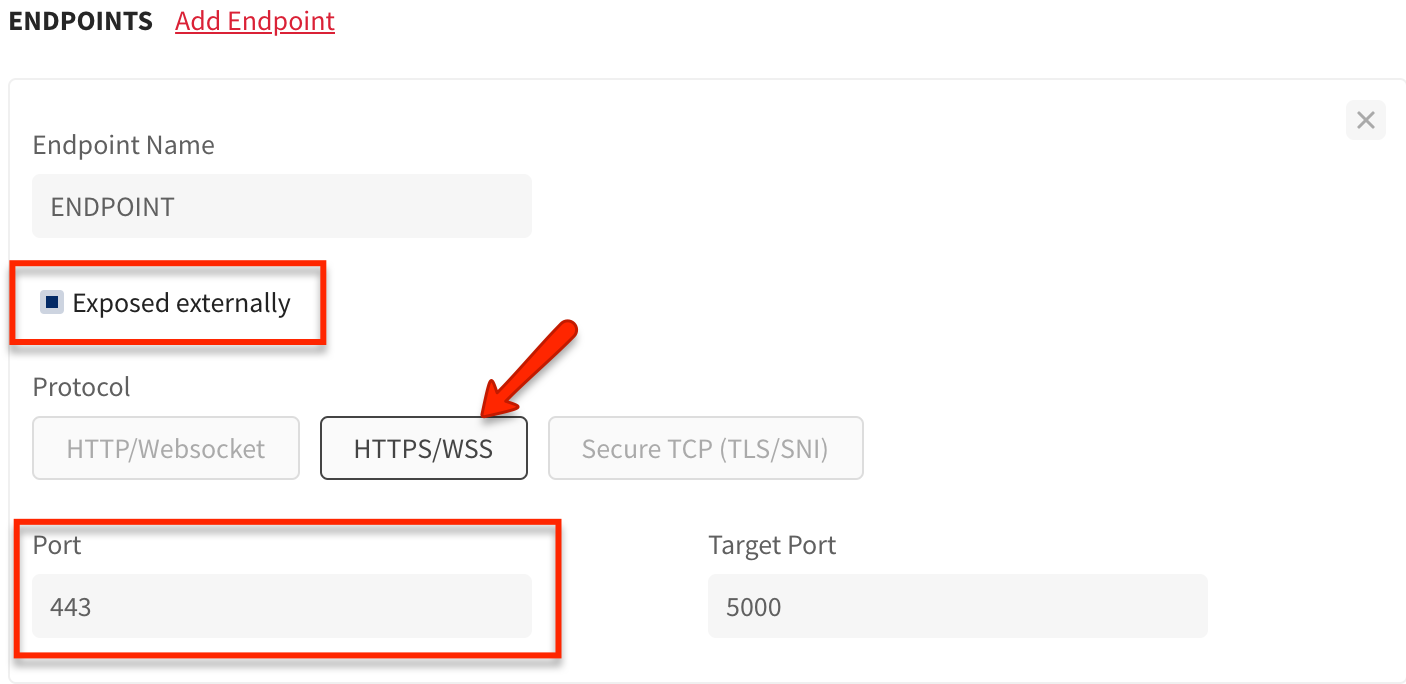
rapyuta.io generates a random URL/route that is exposed on the public internet for the required endpoint when the deployment is created. You can view the Fully Qualified Domain Name (FQDN) of an endpoint on the details page of deployments.
rapyuta.io injects environment variables corresponding to linked network endpoints during deployment binding phase. Refer to the section on Link Injection for more details.
Exposing Endpoints with Static URL
To get a deterministic URL/route for your application while exposing the network endpoint externally, you must bind it to a static route.
rapyuta.io enables you to create a static route URL and give it a globally unique FQDN. When you add a static route, an externally exposed endpoint is essentially guaranteed to be available at the URL of that particular static route. It makes externally exposed endpoints (and hence the deployments exposing them) resilient to failure or re-deployment, facilitates maintenance and upgrades to the backend/deployment while retaining the same unique globally available URL.
To create a static route:
- On the left navigation bar, click STATIC ROUTES.
- Click ADD NEW STATIC ROUTE.
- Enter a name for Static Route URL.
- Click CONTINUE.
Observe that the name of the static route will be a subdomain belonging to .ep-r.io (essentially the provided name will be suffixed with .ep-r.io to form the FQDN). For instance, if the name of the static route is my-example-server, the static route URL will be my-example-server.ep-r.io
The name of a static route has lowercase alphanumeric characters, or a hyphen, and must begin and end with an alphanumeric character, and must not be certain keywords, and it must be at least 4 characters and less than 64 characters long.
Once created, you cannot edit the name of a static route.
To bind a static route to an externally exposed endpoint, which is defined in a package, during the deployment process:
- Click Add Static Route.
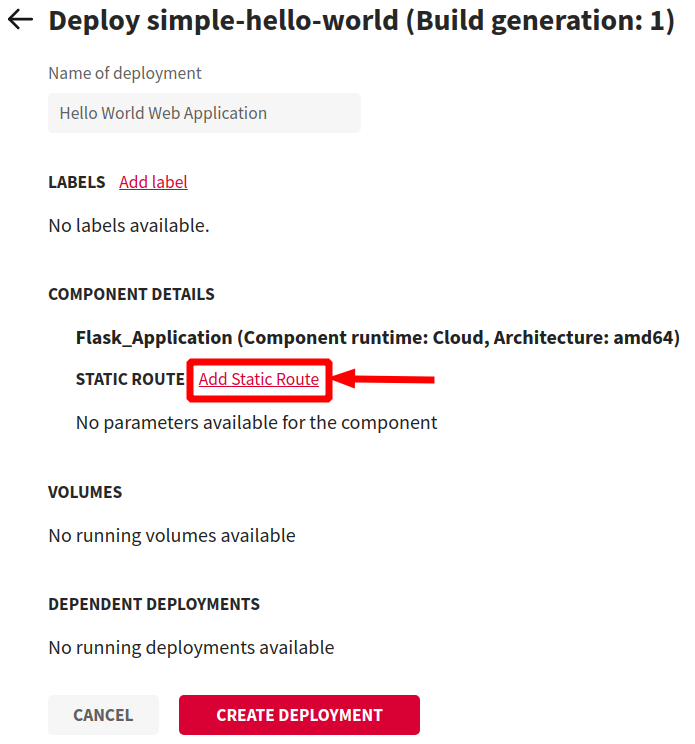
- Select an external network endpoint from the drop-down list.
- Select a static route from the drop-down list.

It creates a mapping between an external network endpoint and a static route. You can unbind a static route from a network endpoint by clicking on the delete icon. In this example, the static route my-example-server is bound to the network endpoint server_endpoint as shown below:
On deploying the package after binding a static route, the network endpoint URL address becomes deterministic and is a constant. It implies that even if the deployment is stopped and provisioned again with the same static route, the network endpoint URL address remains the same.
A package deployment can have multiple static routes. However, a single static route is used for a single deployment.
A static route is globally unique across the rapyuta.io platform.
Refer to billing and usage to understand the limits applied on static routes for different subscription plans.
